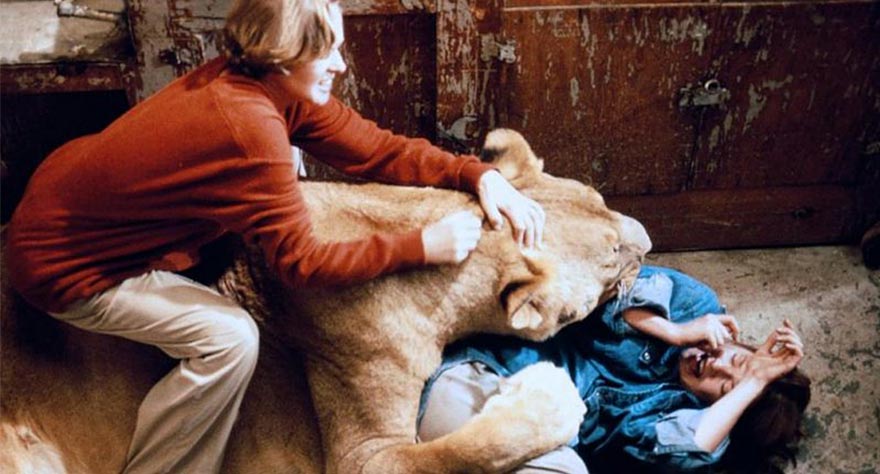
An incoherent mess, a mesmerizing bore, and yet strangely compelling.

An incoherent mess, a mesmerizing bore, and yet strangely compelling.
Roar is a great example of a film overshadowed by the story behind it. In that way, Roar is somewhat similar to Randy Moore’s Escape From Tomorrow, which captivated everyone (including myself) when a filmmaker snuck into Disney World and shot an entire film without anyone noticing. Only here the amusement park of horror doesn’t feature a mouse, but rather hundreds of untrained lions that wreak havoc. Throughout the 102 runtime, big-game cats control each scene by chasing, biting, and knocking down cast members to the ground, resulting in 70 injured crew members during filming. The biggest accomplishment in both these films was not the end product itself, but what they got away with capturing on film. For this reason, a behind behind-the-scenes documentary for these films could be far more intriguing than the narrative versions. Are you listening Werner Herzog?
Describing the plot—if you can call it one—can be done in a few short sentences. A zany zoologist named Hank (Noel Marshall) aims to protect his wild feline friends from African poachers. One day his family decides to visit him and for some reason they end up staying by themselves in a house full of wild lions. Terrified for their lives, both on camera and on set, family members sprint from room to room in an attempt to escape these large wild cats. And honestly, that’s about it in terms of plot.
The intriguing story here has little to do with the actual film and more to do with the back story of how (or why) it was made. Roar is best described as a pet project for wildlife lover Noel Marshall. He serves as the film’s director (his only directing credit), writer (technically co-writer since he gives writing credits to the lions and tigers—seriously), and co-star along with his wife at the time, Tippi Hedren (The Birds). Back in the early 1970s, Marshall and Hedren adopted a lion who actually lived in their home as a pet. At night the lion would often sleep with Hedren’s daughter Melanie Griffith (also in the film), prompting Life magazine to photograph this peculiar family. In less than 10 years they accumulated over 100 big cats and created the Shambala Preserve, an 80-acre wildlife habitat northeast of Los Angeles where they eventually filmed Roar.
When the film debuted back in 1981, it was considered a major flop. After spending 10 years on production with a budget of $17 million, Roar returned a measly $2 million at the box office, along with a batch of sour reviews from critics. Due to the lack of success and popularity, the film became a rarely seen cult classic up until recently when Drafthouse Films—for better or worse—unleashed the film from obscurity by re-releasing it into theaters. So the once hard-to-find film is now easily available to watch, and the question becomes should you actually watch it?
If you’re to watch the film, you must accept that the script is flat-out terrible. There are plenty of dreadful lines like, “Oh God, look what the cat dragged in,” and “Hey, you could have died, dummy.” Not to mention painfully awkward acting across the board. If you can call running from lions and screaming for your life acting—at best it’s improvising human instinct. The fear in their eyes is real, never simulated. It’s the animals that determine the outcome of a scene; actors’ lines sometimes get cut short when a tiger comes at them or disrupt an entire scene with a sudden outburst. Unlike any other film where the director controls the overall pacing, here it’s the lions taking on the duty.
Roar is utterly insane, ridiculous, and audacious. It’s like watching a circus act, the main draw is that there’s a looming sense of danger. On several occasions I found myself flinching from the images on-screen, more so than any horror film, because these people are actually in life-threatening situations. Roar is polarizing in every way. It’s an incoherent mess, a mesmerizing bore, and yet strangely compelling all at the same time. You have to see Roar to believe it, but it’s so bad it’s actually hard to recommend to anyone.
Despite the majority of the film consists of people running and screaming for their lives, the film suddenly shifts tones at the end, swapping dramatic sounds for upbeat music and showing the previously furious animals being cuddly. It’s as if the film is suggesting that these wild animals can make great pets with the right precautions. Seriously? Why would they want to represent wild animals as anything beside what they are? What would motivate someone to make a film like this? How were there no deaths while making this film? These are the great mysteries of Roar, and we can only hope they are one day answered with some DVD extras.